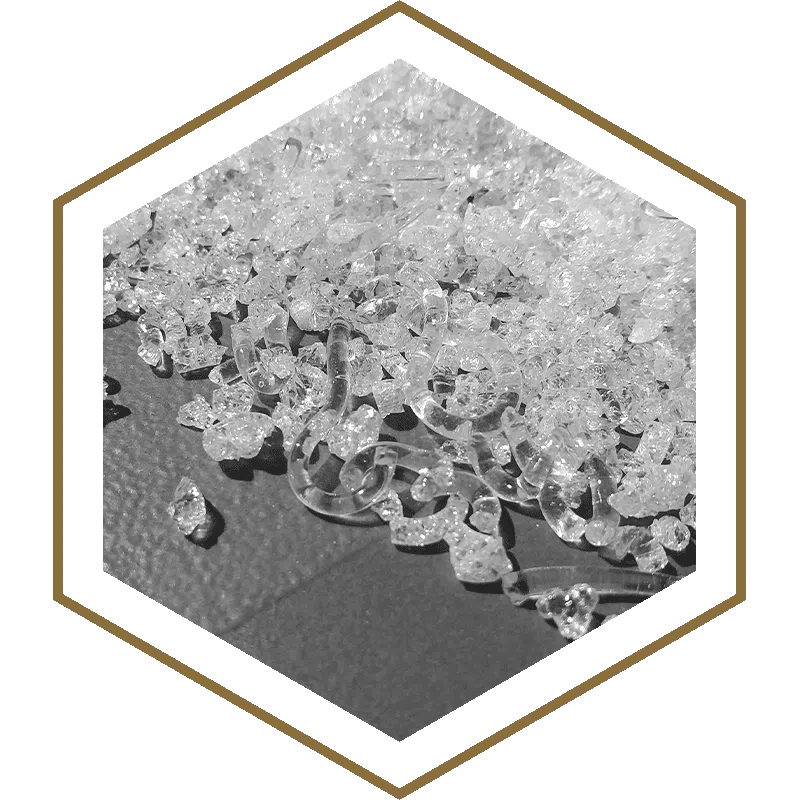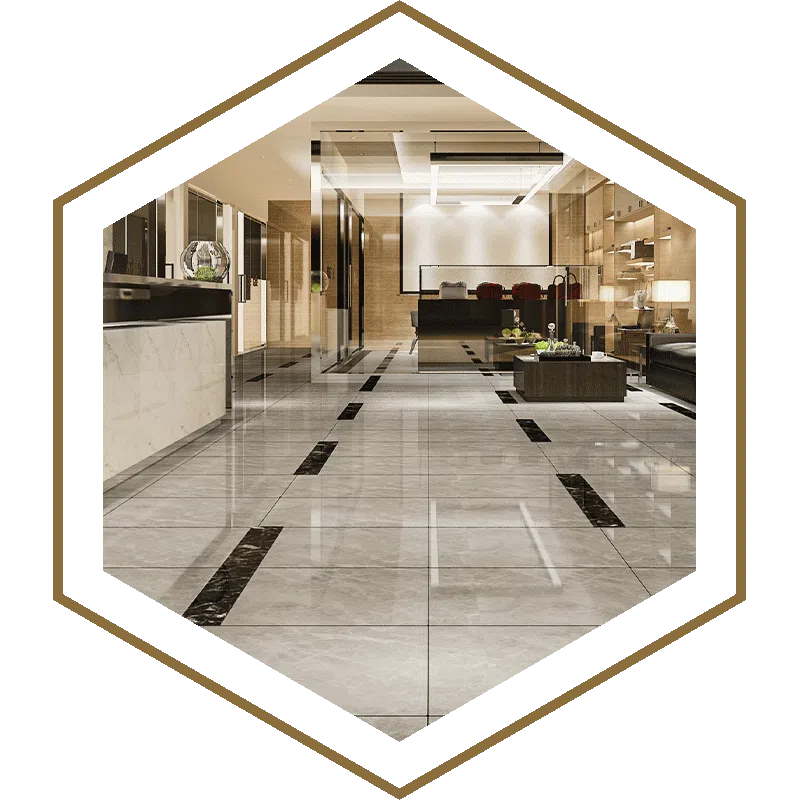If we think of one of the noblest natural materials used since the dawn of history, we cannot avoid referring to ceramics. Its beauty and its intrinsic technical characteristics make it one of the most performing materials, with the possibility of being used in the most different sectors that require high performance.
Unlike some kinds of flooring, which subordinate their characteristics of healthiness and resistance to particular methods of use and maintenance, ceramic is hygienic and has a high resistance. It does not contain plastic, does not deform, resists fire, resists frost and the most aggressive chemical agents, is hypoallergenic, does not smell, does not emit toxic fumes, does not expand or alter, does not promote the growth of fungi, molds or bacteria and it is recyclable. It is very versatile and available in an infinite variety of formats. Installed in a workmanlike manner, it ensures long-lasting stability and hygiene for floors, walls, worktops and surfaces in every room of the house and workplaces.
Thanks to all these characteristics, ceramic is a material that makes the space in which it is installed safe.
All the advantages of ceramic
Ceramic is hygienic
Ceramic, a material so ancient and so modern, has guaranteed hygiene for centuries: so man has used it since ancient times to eat, to mix water and wines, to contain water in basins in which to wash and take care of the body hygiene. Today, with technological innovation and materials engineering, it has become even more performing by further enhancing the basic chemical, physical and mechanical characteristics of the product. The hygiene of ceramics is so daily in human life that it is taken for granted, but it, ceramics, with its washable surfaces, is next to us every day, carrying out its task of caring for our person with constancy and humility, without disappointing us. Never.
Ceramic lasts a long time
Ceramic is a durable material that does not age because it does not deteriorate and is easily cleaned, preventing wear. This is why, even with the passage of time, a ceramic floor is always as good as new. The hardness of the ceramic presents levels of resistance to trampling and abrasion at the top of the classification of coating materials, an aspect that has direct repercussions on the duration of use of the material, which does not require polishing or discounts signs of aging due precisely to the use. And as the comparative life cycle analysis also confirms, ceramic respects the environment because it requires fewer replacements for the same amount of time compared to other materials. In addition, in the event of renovation, the ceramic improves the aesthetic appearance and also guarantees thermal insulation: this means better performance and lower maintenance costs
Ceramic does not burn
Fire, when uncontrolled, creates two enormous problems: it destroys the things it comes into contact with and releases smoke and toxic substances resulting from the combustion process. Ceramic does not burn: it is one of the few materials that, even in contact with an open flame, does not burn and does not release any substance. Ceramic is an inert and fireproof material, made starting from sands and clays and, through a thermal process at 1250 degrees, is transformed into a material with high mechanical and chemical resistance and unalterable over time. A peculiarity of ceramics that is found in all possible uses, whether they are inside the home or outside; be these places of work, shopping, catering or hotels.
Ceramic is resistant
The ceramic does not deform, does not freeze and is not affected by sudden changes in temperature. It is perfectly resistant to the most aggressive chemical detergents and can be used everywhere, even on the external facades of buildings, increasing their aesthetics and ensuring thermal insulation and protection from atmospheric agents. A ceramic floor is strong and durable.
Ceramic is versatile
The term ‘versatile’ refers to the ability to perform different functions. Ceramic can be used anywhere. The technological innovation of the ceramic industry has created, especially in recent years, specific products for various uses and destinations. Thus there is ceramic for exteriors, particularly resistant to thermal and atmospheric stresses, with surfaces that can be walked on without risk in case of rain or that can be positioned around a swimming pool or with characteristics such as to be able to act as an outer layer for large buildings in the case they are used for ventilated walls. Then there is the ceramic for interiors, with thin thicknesses for domestic floors and walls, alongside that for the large dimensions of supermarkets and airports. Then there is also the ceramic to be used as materials for the furniture: bathroom and kitchen tops.
Added to this is the variety of sizes and formats: the old 20×20 tile, which still exists naturally, is flanked by such a variety that starts from the micromosaic of a few millimeters to over three meters of the large slabs.
Finally, the infinite range of colors, designs, decorations and finishes.
Ceramic is stable
A ceramic floor is stable and can be easily installed in shops, offices, restaurants and any type of venue. Ceramic is a practical material for interiors and exteriors, for public or private environments. A ceramic floor, correctly laid according to European standards, is durable and has the best technical and aesthetic performance.
Ceramic loves the environment
If you want to have at home a sustainable material that covers the floors and walls of your home, but also the tops of the bathrooms and the kitchen, think about ceramic. Ceramic is a material that respects the environment starting from the natural raw materials used, which are processed in production cycles characterized by reduced environmental impact, to become products that, due to their intrinsic characteristics and intended uses, protect environmental sustainability.
The ceramic comes from natural raw materials such as clay, feldspar, sands and kaolins, the mixtures of which are transformed in factories whose technologies minimize the use of necessary energy and maximize the recycling of production water. The materials thus produced are characterized by being long-lasting and non-deformable, resistant to freezing and chemical agents, hypoallergenic and odorless, but above all totally recyclable.
Final uses of ceramic
Ceramic is the ideal material for any type of application. It is perfect for terraces, walkways and verandas and allows continuity between indoors and outdoors. It can be vehicular, used for swimming pools, spas and solariums and also as a facade for buildings. Thanks to its good thermal conductivity it is the ideal solution for underfloor heating and can be used in offices and historic buildings for raised floors. It is suitable as a support surface in the kitchen and bathroom, as a door for furniture, tables, doors and furnishing accessories. Contemporary aesthetics, advanced mechanical performance, dimensional flexibility, refined textures, but also hygiene, safety and the ability to resist the attack of aggressive substances present in the kitchen. The new hi-tech surfaces, used for the creation of tops and worktops, are the perfect synthesis of all these theme
Sicer’s glazes and grits for unique surfaces with high technical performance
Sicer’s Digital R&D Lab and Technology Lab are in constant ferment, always looking for highly performing materials for their customers. The products of the manufacturer and supplier of raw materials for ceramic companies of Ubersetto are perfect for creating unique ceramic surfaces with high technical performance. Let’s see some of them in detail.
The GLR soft, total matt & anti-slip range by Sicer
The renewed range of GLR soft, total matt & anti-slip glazes developed by Sicer’s Technology Lab perfectly combines technical and aesthetic characteristics in a single product. This innovative series of non-slip “special glazes” is not commonly composed of frits and single added raw materials, but rather of raw materials brought to the vitreous state, skilfully micronized, applicable like a common glaze. The result is High-Resistance technical surfaces, extremely pleasant to the touch and optimal for furnishing both residential interiors and outdoor or commercial areas.
The glazes of the renewed GLR range have a precise grain size and are supplied ready for use and therefore do not require grinding. Depending on the needs, they can be supplied to the customer in liquid format or in dry format ready for suspension.
Sicer’s GLR soft anti-slip series guarantees:
- A perfect draft.
- Total cleanability.
- Absolute transparency and development of digital colors.
- A final surface totally anti-reflective, natural, material and pleasant to the touch.
- Positive result on the MAZAUD Test. This is a very important test for the French market for measuring the wear resistance of decorated ceramic tiles, according to Cahier CSTB 3778_V4 10/2020 Annexe 10. The test provides that a steel wheel bearing a weight of 60 Kg performs 22320 revolutions (about 14 Km) on a piece of 30 × 30 resting on a rotating support. The test is passed when, following rolling, there is no wear on the surface of the tile, obtaining U4 in the French UPEC class.
The GLR range allows you to calibrate the surface texture according to the necessary value (from R9 to R13) (A + B + C), guaranteeing the regulatory requirements required in each country for the flooring of public spaces.
However, what distinguishes this new range from most anti-slip glazes is the absolute softness of the final surface to the touch.
The series is made up of completely customizable glazes according to customer requests and production conditions.
Technical grits and microgrits by Sicer
Sicer produces a wide range of technical grits and micro-griTs and their excellent quality is the result of the know-how that characterizes the preliminary research phases and production processes.
Sicer’s range of grits and microgrits consists of the following products:
- GHR series of technical floor grits allows the customer to create a wide range of natural surfaces, pleasant to the touch and anti-reflective, ensuring excellent color development of digital graphics and an innate naturalness.
- Neutral GRA grits are distinguished by the materiality of the product that allows single use or customization through different mixtures and effects.
- GRA-DRY LUX grits are an exclusive series of grits for dry application for lapping / mirror polishing. A range of compact transparent grits designed to ensure total transparency and brilliance, no porosity, an incredible depth of the glass and a precise expansion coefficient.
- The colored grits of the GRC series can be used individually or in combination with other grits of the GHR or GRA series. The coloring is in fusion or in mass.
- GRS series presents grits, offered in different grain sizes, with different effects, including: special metallized GSM grits, GRT reactive titanium grits and GRS special grits.
Frequently asked questions
Ceramic grits offer aesthetic and functional versatility. They permit to obtain surfaces with different effects, such as glossy, matt, or anti-reflective finishes, as well as resistance to chemical and abrasive agents. They can be mixed to customise the aesthetic and technical properties of the final product, adapting to the needs of each project.
A high-quality ceramic glaze depends on a balanced formulation of vitrifying agents, fluxes, and stabilisers. This ensures good adhesion to the ceramic surface, strength, and optimum aesthetic performance. Innovation in this field enables glazes that combine aesthetics and technical performance, such as resistance to chemicals and temperature changes.
Recent innovations include transparent grits for mirror lapping, water-based digital adhesives with low emissions and non-slip glazes. These products not only improve aesthetics but also ensure environmental sustainability, chemical resistance, and greater safety in use.
Sicer grits are characterised by a wide range of grit sizes and compositions, allowing for customised, high-quality surfaces. They are available in different effects, including polished, matt, coloured and transparent, and are suitable for different ceramic cycles.
Companies are developing products that use environmentally friendly materials, such as low-emission glues, to reduce environmental impact. These technologically advanced solutions not only preserve the environment but offer modern aesthetic results that combine beauty and durability.









